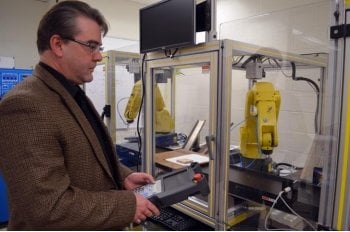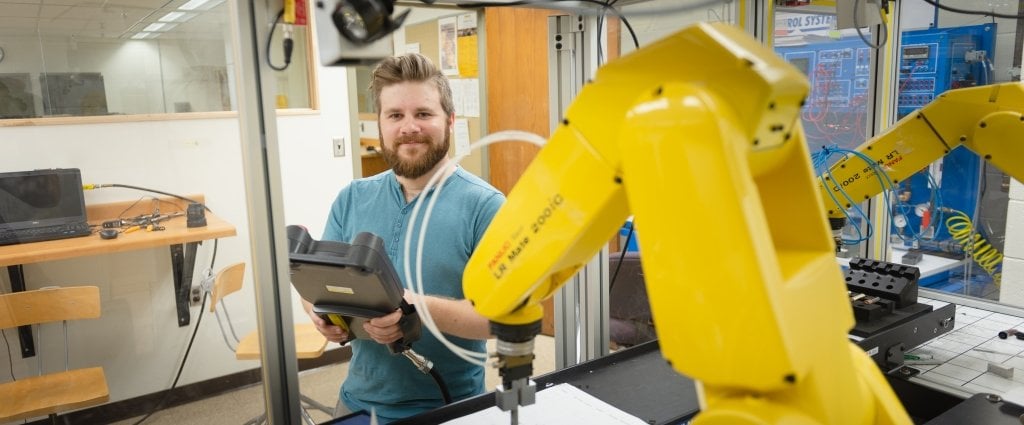How can one educational program teach all the skill sets regional industry requires? Michigan Tech has designed a way.
Industry is not a monolith. One employer needs to hire people with electrical skills. Another is looking for employees who understand fluid power systems. A third needs someone who can read blueprints. How can one educational program meet all their needs?
Partnering with Bay de Noc Community College and funded by the National Science Foundation, the US Department of Labor, state agencies and industry, Michigan Technological University has helped craft an educational program to meet industry’s needs. It’s an initiative in industrial automation, robotics and controls to help students earn credentials from certificates to associate degrees to bachelor’s degrees. The development of the tools and curriculum will prepare Michigan Tech students to join the workforce.
Mechatronics: Automation, Robotics, Controls
What’s mechatronics? Aleksandr Sergeyev, a professor of electrical engineering technology in Michigan Tech’s School of Technology and principal investigator on the project, explained in a recent presentation to the American Society for Engineering Education’s 2018 Conference for Industry and Education Collaboration.
Mechatronics is a hybrid of mechanical, electrical and computer engineering. It is a multidisciplinary field that includes elements of mechanical engineering, electronics, computer engineering, telecommunications, systems engineering, robotics, automation and controls.
And it is the wave of the future. The International Federation of Robotics estimates that by 2019, more than 1.4 industrial robots will be installed in factories around the world.
“Meeting the educational needs of this growing industry was a priority of the partnership between Michigan Tech and Bay College,” Sergeyev says. “But creating separate academic programs to meet each of the diverse requests from area employers was impractical.”
Instead, he worked with Mark Highum, chair of the Technology Division at Bay College, and Scott Kuhl, associate professor of computer science at Michigan Tech, to design a single program.

Specialization to Meet Industry Needs
The program is a “stackable credential model” that includes introductory coursework in each skill set and enables students to customize the rest of their education to focus on the particular regional industry or employer that most interests them.
“Students can choose to earn a single certificate and enter the workforce with it,” Sergeyev explains. “Or they can go on to earn an associate’s degree, enabling them to obtain employment requiring this more advanced skill set. They also have the option to transfer their entire Bay College education to Michigan Tech to earn a bachelor’s degree in electrical engineering technology.”
This model not only works well for students. It provides area employers with potential workers who have entry-level skills as well as associate’s or bachelor’s degree graduates with higher skill sets.
Robotics and Automation are New Normal in Industry
Nick Kaufman, vice president of Kaufman Engineered Systems—the largest integrator of FANUC robots in the USA—says because automation and robotics will continue to be used more and more and new developments will continue to take place, the workplace will need more technicians to maintain, program and design the automation installations.
"We will continue to see areas where manual labor is being replaced by automation, and we need people to support these systems. Students coming out of school need to have the necessary training so they can support this growth."
He went on to say: “The initiative led by Sergeyev focuses on the courses and education to provide the students with the ability to achieve a technical training to complement the theoretical side. I hope we can see the model applied more. This is very important in the support for robotics and automation being installed today.”
Raymond Guzowski, principal engineer in dispense applications and systems of FANUC America and a long-time member of the Industrial Advisory Board of Michigan Tech’s School of Technology Electrical Engineering Technology program, said: “FANUC has supported the Industrial Advisory Board of the School of Technology at Michigan Tech for approximately 25 years. In the past several years under Sergeyev’s leadership, the university has invested in the development of robotic programming classes using FANUC training cells.”
"With the addition of these skills, Michigan Tech students become more valuable to potential employers. FANUC itself has hired a number recent graduates to fill its own staffing requirements."
A number of employers have signed on, including Engineered Machine Products in Escanaba, which has three apprentice programs based on the mechatronics course. Lake Shore Systems, based in Rhinelander, Wisconsin, uses the mechatronics certificate as its apprentice program, according to Mark Highum at Bay College, and three mechatronics students are working at Verso Paper in Escanaba and Stewart Manufacturing in Hermansville.
The program also offers workshops for industry personnel, K-12 and postsecondary educators, and K-12 students. The Dickinson Iron Independent School District recently added a mechatronics program, Highum says. “We have partnered on a fifth-year program that enables their student to complete the Bay College mechatronics program after just one year beyond high school.”
Hands-on Practice with Robotic Arm Simulation
A key element in the mechatronics program is student access to practice with robotics technology. Scott Kuhl, an associate professor of computer science at Michigan Tech, and Sergeyev have worked with nine computer science, electrical and mechanical engineering technology undergraduate and graduate students to develop robotics simulation software called RobotRun that makes the learning experience easily accessible.
“We enjoyed creating a unique, free, open-source software package that helps make industrial robotics training more accessible to everybody,” Kuhl says.
Mechatronics: A Model for Future Technology Education
The mechatronics program is entering its fourth year. “We are currently pursuing various venues to continue supporting the program financially, so we can continue developing existing and new software and hardware functions in the field of robotics,” Sergeyev says. Examples include a tele-operated robotic workcell, enhanced functions of RobotRun, and software including the implementation of robotic vision and a robotic portal for self-learners.
The mechatronics partnership has already caught the attention of the governor and Michigan’s Talent Investment Agency. Both have visited the mechatronics and robotics lab at Bay College, and the agency’s director has expressed interest in participating in future partnerships.
Michigan Tech and Bay College hope to see their model adopted widely. Already, Sergeyev says, many universities and community colleges are using the software—which was freely disseminated during the workshops conducted by the institutions—to teach concepts of industrial robotics. The program offers a path to equip students with educational opportunities in a high-demand industrial field, industrial certification and production of well-prepared graduates with a strong background in industrial automation and controls.
Michigan Technological University is an R1 public research university founded in 1885 in Houghton, and is home to nearly 7,500 students from more than 60 countries around the world. Consistently ranked among the best universities in the country for return on investment, Michigan's flagship technological university offers more than 185 undergraduate and graduate degree programs in science and technology, engineering, computing, forestry, business, health professions, humanities, mathematics, social sciences, and the arts. The rural campus is situated just miles from Lake Superior in Michigan's Upper Peninsula, offering year-round opportunities for outdoor adventure.






Comments